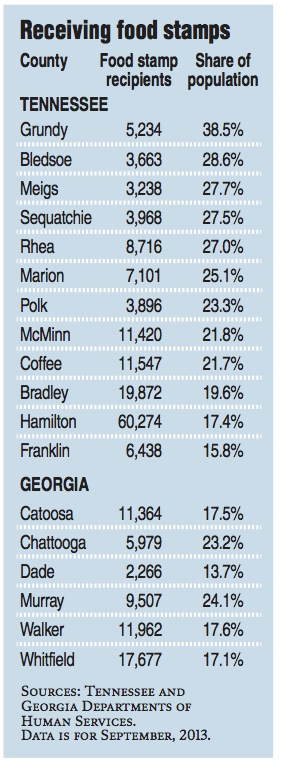 Shawnna Tipton, right, came to Metropolitan Ministries in Chattanooga to get assistance with a bill
and talked with the Chattanooga Area Food Bank's
SNAP program outreach coordinator, Laura Kilpatrick, about signing up again for food stamps. Kilpatrick gave Tipton a local number to call for assistance
if she isn't able to sign up the next time she tries.
Shawnna Tipton, right, came to Metropolitan Ministries in Chattanooga to get assistance with a bill
and talked with the Chattanooga Area Food Bank's
SNAP program outreach coordinator, Laura Kilpatrick, about signing up again for food stamps. Kilpatrick gave Tipton a local number to call for assistance
if she isn't able to sign up the next time she tries.AT A GLANCEAbout the Supplemental Nutrition Assistance Program:* Average monthly benefit: About $275 per household nationally* People affected: 1 in 7 Americans receives benefits* Program's cost: Almost $80 billion a yearU.S. Department of AgricultureWHO IS ELIGIBLEOverview: Most American citizens or legal immigrants with little income and few resources can receive nutrition assistance through the food stamp program. Eligibility depends on total income and expenses within a household.Income: Most food stamp households must have a monthly gross income equal to or less than 130 percent of the federal poverty guidelines, or $2,498 for a family of four.Allowable assets: The program allows deductions from income such as housing costs, child support, medical expenses and child care costs. Households may have up to $2,000 in assets, $3,000 if the household includes an elderly or disabled person. Homes and many vehicles are not counted toward the asset limit.Source: U.S. Department of AgricultureSTATES WITH HIGHEST SNAP PARTICIPATION D.C. - 22 percentMississippi -- 22 percentNew Mexico -- 21 percentOregon -- 21 percentKentucky -- 20 percentLouisiana -- 20 percentTennessee -- 20 percentAlabama -- 19 percentGeorgia -- 19 percentMaine -- 19 percentSource: Pew Charitable TrustSTATE BY STATEIn the tri-state area, here are how many people are expected to receive SNAP benefits next year, the percent of the population and the average benefit per month:* Tennessee: More than 1.3 million, about 20 percent of the population, average monthly benefit: $272* Georgia: More than 1.9 million, 19 percent of the population, $296* Alabama: About 910,000, 19 percent, $281Source: Pew Charitable Trust
Shawnna Tipton is a single mom who just wants to feed her family, but she is having a hard time doing that.
She is one of 1.9 million Georgians on food stamps who once could visit Georgia's Department of Family and Children Services and find help periodically to reapply for food stamps, also called the Supplemental Nutrition Assistance Program. But this year, the office staff was reduced to a receptionist who points clients to computer kiosks to apply for food stamps and gives them a toll-free number if they have questions.
Tipton said she spent three hours on the phone recently and still wasn't able to successfully reapply.
Now, feeding her family has gotten even harder in another way.
She is among the 23 million households, or nearly 48 million Americans, dealing with the estimated 5 percent-per-family cut in food stamps that took effect Friday.
That's a big deal for her because the $367 a month she once received in food stamps is her biggest source of income.
Tipton has no job, and she also provides for her 16-year-old pregnant daughter.
With the 5 percent cut, a family of two like Tipton's will lose $20 a month in benefits. A family of four receiving the maximum allotment would see their benefits decrease from $668 to $632, or $36 a month.
The cut marks the end of stimulus funding first provided to families on food stamps in 2009 to help them get through the tight economy, said state Rep. JoAnne Favors, D-Chattanooga. She wanted the stimulus funding to be extended for food stamp recipients, but an extension was not supported, she said.
"In Hamilton County we still have high unemployment, and groceries are still expensive," said Favors.
More than 60,000 food stamp recipients live in Hamilton County. That's more than 17 percent of the population.
But for all the challenge facing Tipton and other food stamp recipients, another potential benefit reduction looms.
Congress has begun negotiations on further cuts to the program.
•••
In all, about 1 in 7 Americans receives food stamps.
Tennessee ranks among the top seven states for food stamp use, followed by Alabama and Georgia, according to the Pew Charitable Trust. About 20 percent of Tennessee's population receives food stamps, compared to about 19 percent in Alabama and Georgia, Pew found.
But usage isn't even across the Chattanooga area. Nearly 40 percent of Grundy County's population receives food stamps, and eight other area counties have more recipients than the Tennessee state average.
Food stamps fluctuate based on factors that include food prices, inflation and income. The rolls have swelled as the economy has struggled in recent years, with the stimulus providing higher benefits and many people signing up for the first time.
As a result, the program has more than doubled in cost since 2008, to almost $80 billion a year. That increase has turned the program into a target for congressional Republicans looking to reduce spending.
The U.S. House passed a farm bill in mid-September proposing an average $4 billion cut from the food stamp program per year, compared to a proposed $400 million cut in the Senate. Lawmakers separated the farm bill into two parts, one with subsidies for farmers and the other supporting nutritional programs like SNAP.
"With that separation, nutrition programs are more vulnerable and susceptible to more cuts," said Laura Kilpatrick, the Chattanooga Area Food Bank's SNAP program outreach coordinator.
Charities say they are preparing for the farm bill reductions as well as the scheduled cuts that took place Friday.
The Chattanooga Area Food Bank received a $50,000 Feeding America Network grant to help Tipton and people like her sign up for food stamps. Getting more people who qualify onto food stamps will help relieve the pressure charities expect as a result of the benefit reduction that took effect Friday.
"Charities cannot fill the gap for the cuts being proposed to SNAP," said Maura Daly of Feeding America, a network of the nation's food banks. "We are very concerned about the impact on the charitable system."
Kilpatrick agreed.
"It's quite unfortunate," she said. "People who don't understand think that the food stamp program is a huge moneymaker for some clients, but it's not. Some people have less than $5 a day to feed themselves."
The Associated Press contributed to this report.
Contact staff writer Yolanda Putman at yputman@timesfreepress.com or 423-757-6431.

